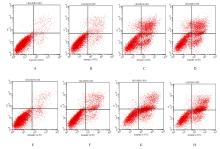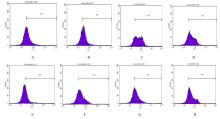| 1 |
VODUC K D, CHEANG M C, TYLDESLEY S,et al. Breast cancer subtypes and the risk of local and regional relapse[J]. J Clin Oncol, 2010, 28(10): 1684-1691.
|
| 2 |
CHEN X X, YU X L, CHEN J Y, et al. Analysis in early stage triple-negative breast cancer treated with mastectomy without adjuvant radiotherapy: patterns of failure and prognostic factors[J].Cancer,2013,119(13): 2366-2374.
|
| 3 |
Favourable and unfavourable effects on long-term survival of radiotherapy for early breast cancer: an overview of the randomised trials[J]. Lancet, 2000, 355(9217): 1757-1770.
|
| 4 |
WOJCIK S. Crosstalk between autophagy and proteasome protein degradation systems: possible implications for cancer therapy[J]. Folia Histochem Cytobiol, 2013, 51(4): 249-264.
|
| 5 |
BASCHNAGEL A, RUSSO A, BURGAN W E,et al. Vorinostat enhances the radiosensitivity of a breast cancer brain metastatic cell line grown in vitro and as intracranial xenografts[J].Mol Cancer Ther,2009,8(6): 1589-1595.
|
| 6 |
FEDELE P, ORLANDO L, CINIERI S. Targeting triple negative breast cancer with histone deacetylase inhibitors[J]. Expert Opin Investig Drugs, 2017, 26(11): 1199-1206.
|
| 7 |
田竹筠, 杨春旺, 蔡祖超, 等. 丙戊酸对乳腺癌MCF7细胞的放射增敏性依赖于抑癌基因p53[J]. 中国药理学与毒理学杂志, 2019, 33(4): 257-264.
|
| 8 |
FOSS F, HORWITZ S, PRO B, et al. Romidepsin for the treatment of relapsed/refractory peripheral T cell lymphoma: prolonged stable disease provides clinical benefits for patients in the pivotal trial[J]. J Hematol Oncol, 2016, 9: 22.
|
| 9 |
FERNÁNDEZ-AROCA D M, ROCHE O, SABATER S, et al. P53 pathway is a major determinant in the radiosensitizing effect of Palbociclib: implication in cancer therapy[J]. Cancer Lett, 2019, 451: 23-33.
|
| 10 |
ORONSKY B, ORONSKY N, SCICINSKI J, et al. Rewriting the epigenetic code for tumor resensitization: a review[J]. Transl Oncol, 2014, 7(5): 626-631.
|
| 11 |
SIEGEL R L, MILLER K D, JEMAL A. Cancer statistics, 2020[J].CA Cancer J Clin,2020,70(1): 7-30.
|
| 12 |
TONG C W S, WU M X, CHO W C S, et al. Recent advances in the treatment of breast cancer[J]. Front Oncol, 2018, 8: 227.
|
| 13 |
CHENG Y, HE C, WANG M N, et al. Targeting epigenetic regulators for cancer therapy: mechanisms and advances in clinical trials[J]. Signal Transduct Target Ther, 2019, 4: 62.
|
| 14 |
WAWRUSZAK A, LUSZCZKI J J, GRABARSKA A, et al. Assessment of interactions between cisplatin and two histone deacetylase inhibitors in MCF7, T47D and MDA-MB-231 human breast cancer cell lines-an isobolographic analysis[J].PLoS One, 2015,10(11): e0143013.
|
| 15 |
CHIU H W, YEH Y L, WANG Y C, et al. Suberoylanilide hydroxamic acid, an inhibitor of histone deacetylase, enhances radiosensitivity and suppresses lung metastasis in breast cancer in vitro and in vivo [J]. PLoS One, 2013, 8(10): e76340.
|
| 16 |
RAHA P, THOMAS S, THURN K T, et al. Combined histone deacetylase inhibition and tamoxifen induces apoptosis in tamoxifen-resistant breast cancer models, by reversing Bcl-2 overexpression[J]. Breast Cancer Res, 2015, 17(1): 26.
|
| 17 |
GRABARSKA A, ŁUSZCZKI J J, NOWOSADZKA E,et al. Histone deacetylase inhibitor SAHA as potential targeted therapy agent for larynx cancer cells[J]. J Cancer, 2017, 8(1): 19-28.
|
| 18 |
GUMBAREWICZ E, LUSZCZKI J J, WAWRUSZAK A, et al. Isobolographic analysis demonstrates additive effect of cisplatin and HDIs combined treatment augmenting their anti-cancer activity in lung cancer cell lines[J].Am J Cancer Res,2016,6(12): 2831-2845.
|
| 19 |
HEERS H, STANISLAW J, HARRELSON J, et al. Valproic acid as an adjunctive therapeutic agent for the treatment of breast cancer[J]. Eur J Pharmacol, 2018, 835: 61-74.
|
| 20 |
WAWRUSZAK A, GUMBAREWICZ E, OKON E, et al. Histone deacetylase inhibitors reinforce the phenotypical markers of breast epithelial or mesenchymal cancer cells but inhibit their migratory properties[J]. Cancer Manag Res, 2019, 11: 8345-8358.
|
| 22 |
缪雨季,周 倬,常 青.甲氟喹对胶质瘤细胞的放射增敏作用[J].中国医学物理学杂志,2021,38(1):6-10.
|
| 23 |
MRAKOVCIC M, BOHNER L, HANISCH M, et al. Epigenetic targeting of autophagy via HDAC inhibition in tumor cells: role of p53[J].Int J Mol Sci,2018,19(12): E3952.
|
| 24 |
SHARDA A, RASHID M, SHAH S G, et al. Elevated HDAC activity and altered histone phospho-acetylation confer acquired radio-resistant phenotype to breast cancer cells[J]. Clin Epigenetics, 2020, 12(1): 4.
|
| 25 |
CARLISI D, LAURICELLA M, D'ANNEO A, et al. The synergistic effect of SAHA and parthenolide in MDA-MB231 breast cancer cells[J]. J Cell Physiol, 2015, 230(6): 1276-1289.
|
| 26 |
LEE J Y, KUO C W, TSAI S L, et al. Inhibition of HDAC3- and HDAC6-promoted survivin expression plays an important role in SAHA-induced autophagy and viability reduction in breast cancer cells[J]. Front Pharmacol, 2016, 7: 81.
|
| 27 |
CHIU H W, YEH Y L, WANG Y C, et al. Combination of the novel histone deacetylase inhibitor YCW1 and radiation induces autophagic cell death through the downregulation of BNIP3 in triple-negative breast cancer cells in vitro and in an orthotopic mouse model[J]. Mol Cancer, 2016, 15(1): 46.
|
| 28 |
ZHOU Z R, ZHU X D, ZHAO W, et al. Poly(ADP-ribose) polymerase-1 regulates the mechanism of irradiation-induced CNE-2 human nasopharyngeal carcinoma cell autophagy and inhibition of autophagy contributes to the radiation sensitization of CNE-2 cells[J]. Oncol Rep, 2013, 29(6): 2498-2506.
|
| 29 |
CHAACHOUAY H, OHNESEIT P, TOULANY M, et al. Autophagy contributes to resistance of tumor cells to ionizing radiation[J]. Radiother Oncol, 2011, 99(3): 287-292.
|
 )
)
 )
)




